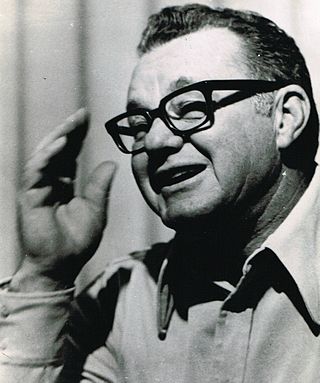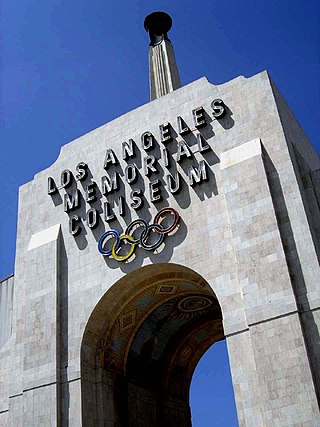
Norman Mack Van Brocklin, nicknamed "the Dutchman", was an American football quarterback and coach who played in the National Football League (NFL) for 12 seasons. He spent his first nine seasons with the Los Angeles Rams and his final three with the Philadelphia Eagles. Following his playing career, he was the inaugural head coach of the Minnesota Vikings from 1961 to 1966 and the second head coach of the Atlanta Falcons from 1968 to 1974.

Leonard Guy Ford Jr. was an American professional football player who was an offensive and defensive end from 1948 to 1958. He played college football for the University of Michigan and professional football for the Los Angeles Dons, Cleveland Browns and Green Bay Packers. He was inducted into the Pro Football Hall of Fame in 1976 and the University of Michigan Athletic Hall of Honor in 1996.

Robert Stanton Waterfield was an American football player and coach. A skilled player, he played in the National Football League (NFL) for eight seasons, primarily as a quarterback, but also as a safety, kicker, punter and sometimes return specialist with the Cleveland / Los Angeles Rams. He played college football for the UCLA Bruins. He was inducted into the Pro Football Hall of Fame in 1965. His No. 7 jersey was retired by the Rams in 1952. He was also a motion picture actor and producer.
The 1950 NFL season was the 31st regular season of the National Football League. The merger with the All-America Football Conference (AAFC) expanded the league to 13 teams. Meanwhile, television brought a new era to the game. The Los Angeles Rams became the first NFL team to have all of its games – both home and away – televised. The Washington Redskins became the second team to put their games on TV. Other teams arranged to have selected games televised.
The 1952 NFL season was the 33rd regular season of the National Football League. Prior to the season, the legacy of the Dayton Triangles, the final remaining Ohio League member and the franchise then known as the New York Yanks owner Ted Collins sold his team back to the NFL. A few days later, a new team was then awarded to an ownership group in Dallas, Texas, after it purchased the assets of the Yanks.

Joseph Lee Stydahar nicknamed "Jumbo Joe", was an American football player and coach. He was inducted into the Pro Football Hall of Fame in 1967 and the College Football Hall of Fame in 1972.

Weldon Gaston "Hum" Humble was an American football guard who played five seasons in the All-America Football Conference (AAFC) and National Football League (NFL) for the Cleveland Browns and Dallas Texans in the late 1940s and early 1950s.
The 1951 NFL Championship Game was the National Football League's 19th championship game, played December 23 at the Los Angeles Memorial Coliseum in Los Angeles, California.

The 1950 NFL Championship Game was the 18th National Football League (NFL) title game, played on Sunday, December 24 at Cleveland Stadium in Cleveland, Ohio.
The 1950 National Football League playoffs took place after the 1950 regular season ended with a tie for first place in both the American and National conferences. The ties forced one-game playoffs to determine who would play in the NFL championship game. It was the only time in the NFL's championship game era that two such tiebreaker playoff games were needed in the same year. The Cleveland Browns and New York Giants tied for first place in the American Conference, while the Chicago Bears and Los Angeles Rams tied for first place in the National Conference. The Browns proceeded to beat the Giants 8–3, and the Rams beat the Bears 24–14 in their playoff game. Cleveland then beat the Rams in the championship game the following week. The home teams won all three games in this postseason.
The 1955 NFL Championship Game was the 23rd league championship game, played on December 26 at the Los Angeles Memorial Coliseum in Los Angeles, California.
The 1976 Pro Bowl was the NFL's 26th annual all-star game which featured the outstanding performers from the 1975 season. The game was played on Monday night, January 26, 1976, at the new Louisiana Superdome in New Orleans, Louisiana, with 32,108 in attendance. The final score was NFC 23, AFC 20. It was also the first Pro Bowl game played indoors.

Clifford Allen Lewis was a professional American football player for the Cleveland Browns of the All-America Football Conference (AAFC) and National Football League (NFL). He was the team's first quarterback.

The 1970 Pro Bowl was the National Football League's twentieth annual all-star game which featured the outstanding performers from the 1969 season. The game was played on Sunday, January 18, 1970, at Los Angeles Memorial Coliseum in Los Angeles, California. The final score was West 16, East 13. Running back Gale Sayers of the Chicago Bears was named the game's offensive Most Valuable Player (MVP) for the third time after rushing for 75 yards on nine carries. Defensive end George Andrie of the Dallas Cowboys was selected as the defensive MVP.

The 1966 Pro Bowl was the National Football League's sixteenth annual all-star game which featured the outstanding performers from the 1965 season. The game was played on January 16, 1966, at the Los Angeles Memorial Coliseum in Los Angeles, California, with an attendance of 60,124. The West was favored by a touchdown, but the East won in a rout, 36–7.

The 1963 Pro Bowl was the National Football League's thirteenth annual all-star game which featured the outstanding performers from the 1962 season. The game was played on January 13, 1963, at the Los Angeles Memorial Coliseum in Los Angeles, California, under sunny skies in front of 61,374 fans.
The 1962 Pro Bowl was the National Football League's twelfth annual all-star game which featured the outstanding performers from the 1961 season. The game was played on January 14, 1962, at the Los Angeles Memorial Coliseum in Los Angeles, California in front of 57,409 fans.
The 1954 Pro Bowl was the National Football League's (NFL) fourth annual all-star game which featured the league's outstanding performers from the 1953 season. The game was played on January 17, 1954, at the Los Angeles Memorial Coliseum in Los Angeles, California in front of 44,214 fans. The East squad defeated the West by a score of 20–9.
The 1953 Pro Bowl was the NFL's third annual all-star game which featured the league's outstanding performers from the 1952 season. The game was played on January 10, 1953, at the Los Angeles Memorial Coliseum in Los Angeles, California in front of 34,208 fans. The National Conference squad defeated the American Conference by a score of 27–7.
The 1952 Pro Bowl was the NFL's second annual all-star game which featured the league's outstanding performers from the 1951 season. The game was played on January 12, 1952, at the Los Angeles Memorial Coliseum in Los Angeles, California in front of 19,400 fans. The National Conference squad defeated the American Conference by a score of 30–13.








